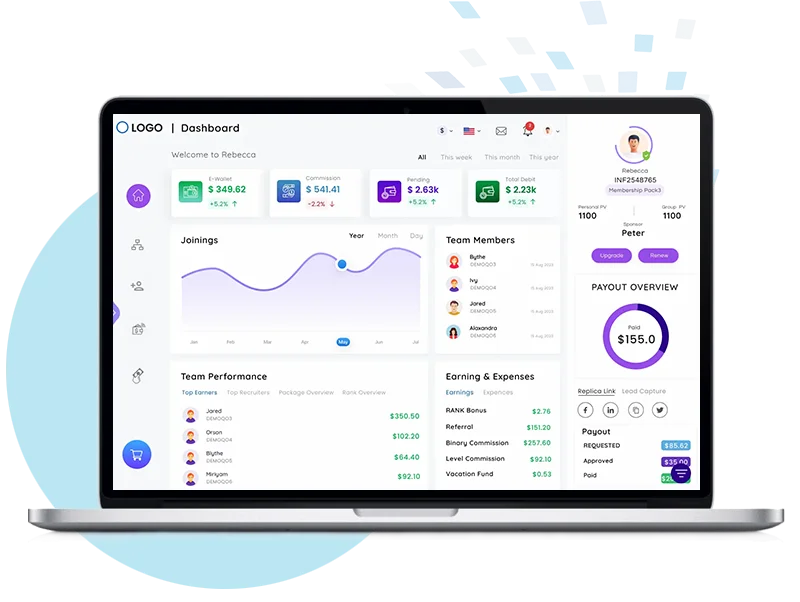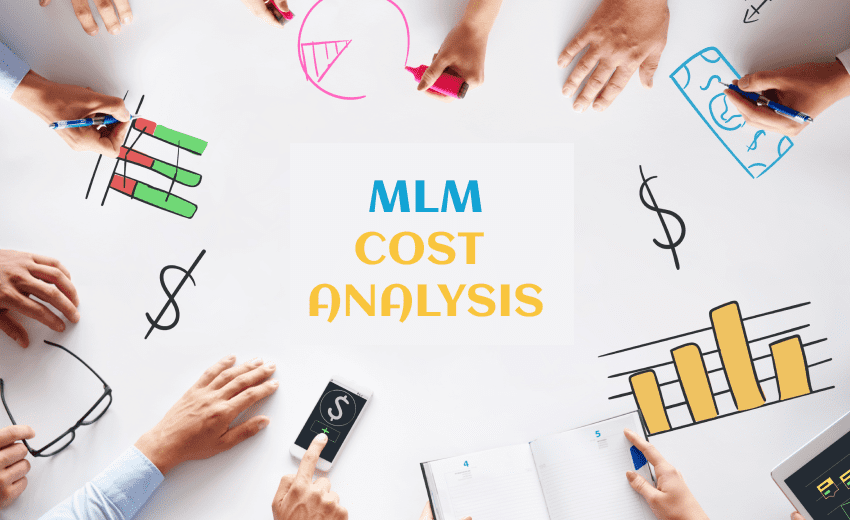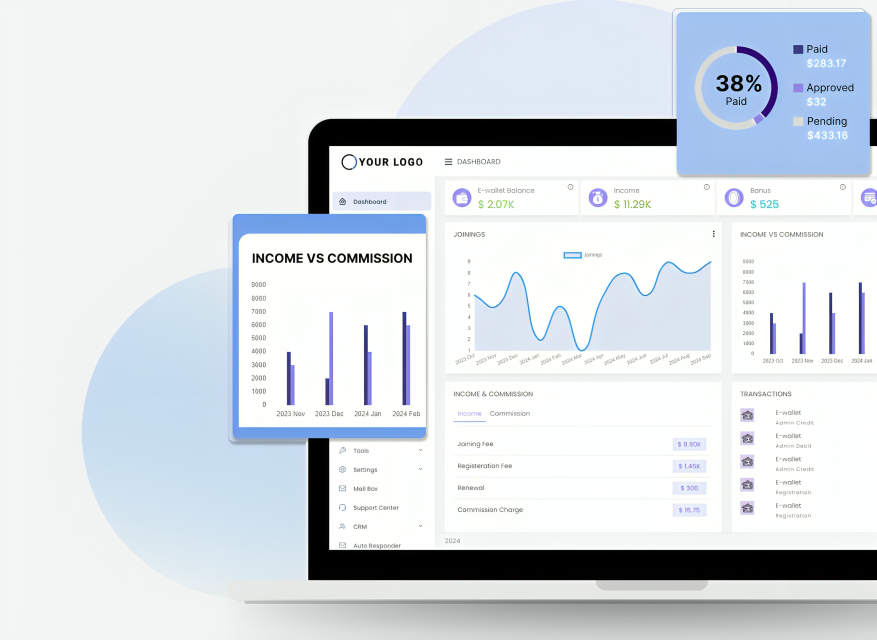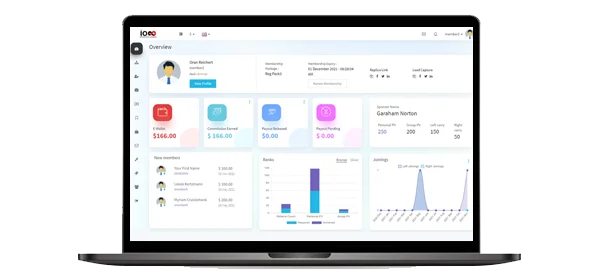Understanding the true cost of MLM software is important as prices can range from under $1,000 for a basic, pre-built package to over $30,000 for a fully customized, enterprise-level system. With such a wide spectrum, it’s easy for multi-level marketing business owners to feel uncertain about where their investment should fall.
In this blog, we will simplify MLM software pricing, breaking down every component from initial setup and customization to long-term maintenance and support. You’ll learn how compensation plans and business size affect cost, to the differences between one-time, subscription and open-source solutions.
By the end of this guide, you’ll have a crystal-clear understanding of what influences MLM software pricing, how to budget effectively, and why a strategic investment in the right solution can maximize your ROI and ensure sustainable growth. Let’s go!
Why MLM Software Is a Non-Negotiable Investment for Growth
MLM software is a must-have for any direct selling business aiming to grow efficiently and maximize ROI. It turns complex network operations into simplified, automated workflows that drive growth, transparency and revenue.
-
Automation and Efficiency
Automate commission tracking, network management, sales, payments and inventory in one platform. This efficiency reduces manual effort and minimizes errors.
-
Distributor Engagement and Performance
Empower your distributors with intuitive dashboards, real-time insights, and performance tracking tools. Higher engagement results in stronger sales and customer retention.
-
Transparency and Compliance
Ensure accurate payouts, secure transactions and compliance with legal and financial regulations, building lasting trust and credibility within your network.
-
Growth and Flexibility
From startup to enterprise, MLM software adapts to your business model, product range, and global expansion goals without compromising performance.
-
Data-Driven Growth
Access real-time analytics to track network performance, forecast trends and make informed business decisions that improve profitability.
-
Proven ROI
While the initial investment may seem significant, MLM software brings measurable returns through automation, accuracy and increased sales.
Understanding MLM Software Pricing Models: One-Time, Subscription and Open-Source
When it comes to MLM software, understanding the pricing model is just as important as knowing the features. Let’s break down the three most common pricing models to help you choose the one that best fits your goals and budget.
-
1. One-Time Purchase (License Model)
The One-Time Purchase model involves a single upfront payment to purchase a lifetime license for the software. Once you pay, you own the license and can use the system indefinitely.
Pros:- Full ownership and control over the software.
- No recurring subscription fees.
- Customization flexibility to meet unique business requirements.
- Higher initial investment.
- Responsibility for hosting, maintenance and updates often falls on the buyer.
Typical Cost: Can start around $5,000 and go upward depending on the software’s complexity, features, and integration needs.
-
2. Subscription-Based (SaaS Model)
Under the Subscription-Based model, you pay a monthly or yearly subscription fee for access to the software, which is typically hosted on the provider’s cloud servers.
Pros:- Lower upfront costs and predictable monthly expenses.
- Includes hosting, maintenance, security, and regular feature updates.
- Quick deployment and easy scalability as your network grows.
- Continuous recurring payments over time.
- Limited access to the software’s core code and customization options.
Typical Cost: Ranges from under $100 to over $1,000 per month, depending on features, user capacity, and support level.
-
3. Open-Source Software
Open-source MLM software is technically free to use, but requires advanced technical expertise for installation, customization and maintenance.
Pros:- Complete flexibility to modify the software as needed.
- No licensing fees or vendor restrictions.
- Requires skilled developers or consultants for implementation.
- Hidden costs related to development, security, and long-term upkeep.
- Time-intensive setup and maintenance process.
Typical Cost: While the software itself may be free, expenses arise from hiring consultants or maintaining an in-house development team to manage and support the system.
Key Factors Influencing Your MLM Software Investment
Determining the true cost of MLM software goes far beyond the initial purchase price. Multiple variables all shape the total investment. Understanding these key factors ensures you make informed, ROI-driven decisions that align with your business strategy.
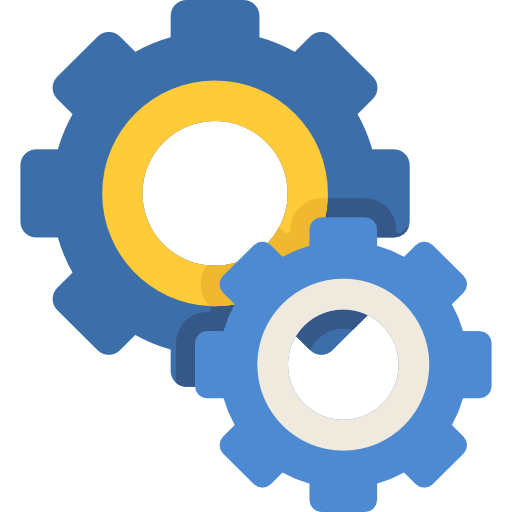
Compensation Plan Complexity
Your MLM compensation plan directly impacts software development costs.
- Simple plans like Binary, Matrix, or Unilevel are faster and less expensive to implement.
- Complex or hybrid plans involving multiple tiers, payout layers and performance metrics require advanced coding, increasing overall cost.

Level of Customization
Off-the-shelf software is more affordable but limited in flexibility, while custom-built MLM software offers a personalized fit for your unique business model, branding and workflows.
- Off-the-shelf: Quicker to deploy, lower initial cost.
- Custom-built: Higher upfront investment but designed for smooth integration with your existing systems.

Business Size & Growth
Your network size and growth ambitions heavily influence pricing.
- Startups: With smaller distributor networks can opt for budget-friendly packages.
- Enterprises: Managing large, global networks require advanced analytics and higher server capacity, all of which increase cost.

Features & Integrations
The number of features and third-party MLM integrations directly affect your software’s total cost. Premium MLM solutions often include:
- E-commerce and payment gateway integration
- CRM or ERP connectivity
- Mobile app compatibility (Android/iOS)
- E-wallet and commission management
- Multi-currency and multi-language support
- Real-time analytics and reporting tools

Technology Stack
The underlying MLM technologies such as programming language, database, and hosting environment play a major role in pricing. Advanced frameworks and databases may increase cost but deliver better performance and long-term security.

Security & Compliance
Modern MLM platforms must meet strict data protection and compliance standards. Software with built-in fraud prevention, data encryption, and GDPR compliance commands a higher price but ensures long-term trust and legal safety.

Vendor Experience & Reputation
Established vendors with proven MLM software expertise often charge more, but their track record, reliability, and post-launch support justify the premium. Partnering with an experienced provider minimizes risks and ensures your project stays on schedule and budget.

Ongoing Support, Maintenance & Training
Post-deployment costs are an important part of your investment. Some subscription plans include updates and support, while others may charge separately for bug fixes, version upgrades, technical support, troubleshooting, and user training or onboarding.

Hosting & Infrastructure
For one-time purchase models, hosting is usually the user’s responsibility, with costs covering domain registration, server hosting (whether cloud-based or on-premise) and bandwidth and storage requirements.

Consulting Services
Strategic consulting can help you optimize implementation and ROI. Whether billed hourly or per project, these services assist with plan selection, system optimization, and growth strategies, ensuring you extract maximum value from your investment.
Average Cost of MLM Software Development
Depending on your business size, compensation plan, and required features, MLM software development typically ranges from $10,000 to $75,000 or more.
To determine the most accurate estimate, it’s recommended to consult with expert MLM software vendors who can assess your requirements and customize a solution that fits your operational and financial goals.
MLM Software Cost Breakdown by Business Scale (Estimated for 2025)
Understanding how MLM software pricing scales with business size helps you budget strategically and choose the right plan for your current growth stage. Below is a clear cost breakdown based on functionality and support requirements, reflecting the latest 2025 industry estimates.
| Business Scale | Key Features | Estimated One-Time Cost | Estimated Subscription Cost |
|---|---|---|---|
| Startup (Basic Needs) | Essential tools like distributor registration, commission tracking, basic genealogy/network visualization, simple reporting dashboard. | $2,000 – $7,000 | $99 – $299/month |
| Growing Business (Expanding Needs) | Moderate customization, branded dashboards, e-wallet integration, mobile app compatibility, improved analytics, and better flexibility. | $10,000 – $25,000 | $300 – $800/month |
| Large Enterprise (Custom & Complex Needs) | Fully custom-built system with multi-currency and multi-language support, advanced security, enterprise-grade integrations (CRM/ERP), and API support. | $30,000+ | $1,000+/month |
 Did You Know?
Did You Know?
As per reports The size of the MLM Software Market was estimated at USD 600 million in 2024 and is expected to expand at a CAGR of 9.97% to reach USD 1,259.12 million by 2031.
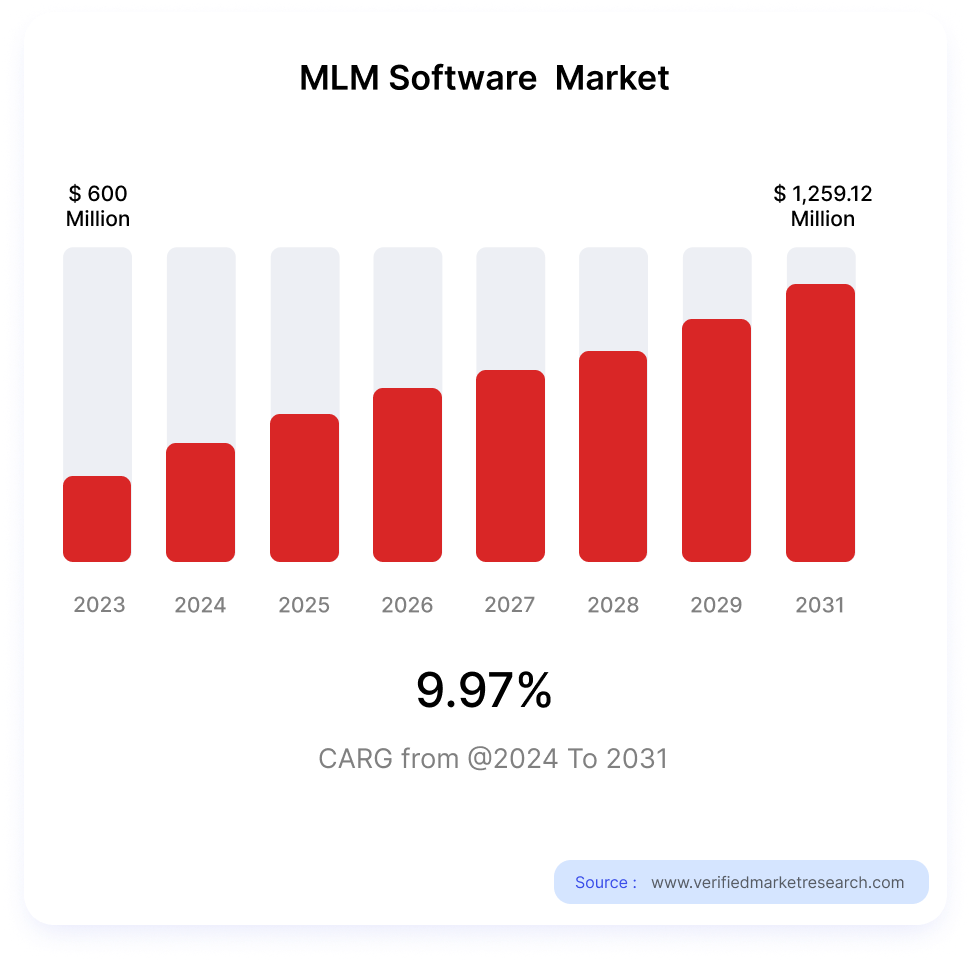
What are the Direct Expenses in MLM Software Development?
Here’s a breakdown of the main factors that affect the cost of developing MLM software:
Salaries for development teams, and other staff.
Costs for computing resources, including buying equipment and software needed for development.
Customizing MLM software to match your business requirements and branding may lead to extra costs.
Expenses for adding custom features, integrations, and functionalities specific to your MLM business model.
Costs for designing a user-friendly interface and intuitive user experience tailored to your target audience.
Expenses for utilities like power and internet, as well as infrastructure. Licensing software for efficient and distributed development is also a shared resource.
These costs can increase if additional funds are needed to manage risks related to software development. All of this can make in-house development quite expensive. By working with an MLM software development company, you can reduce these costs,as they already have the necessary setup and resources for software development and support.
What are the Indirect Expenses in MLM Software Development?
Apart from direct expenses, there are several indirect expenses that can impact the overall cost of MLM software development. Indirect expenses are often overlooked but play a significant role in the total cost of mlm software.

Investing in software engineering helps ensure the MLM software meets its goals and provides the best value.

Costs for internal and external reviews to ensure the MLM software aligns with the project plan.

Expenses for tools and technologies to boost the software’s security without affecting its performance.

Costs associated with meeting international IT and software development standards.

Costs associated with using project management software, collaboration tools, and communication platforms.

Fees for consulting experts, business analysts, and strategists to plan and oversee the MLM software development process.

Costs for monitoring, updating, and maintaining server infrastructure, ensuring optimal performance and security.
Managing these indirect expenses can be challenging if you’re developing MLM software in-house for the first time, and it may increase risks. Partnering with an experienced MLM software development firm can help reduce the cost of MLM software development, as they are well-versed in security and regulatory compliance and can ensure high-quality software development.
Popular MLM Software Prices: A Comparative Look
Below is a comparative overview of popular MLM software, highlighting starting costs and key features to help businesses select the best fit for their needs.

Infinite MLM Software
Basic – $699
Features
- Dashboard
- Downline Graphical View
- User Overview
- Tools
- Mailbox
- Ewallet Management
- Profile Management
- Reports
- New Member Registration
- Settings
- Payout Systems
- E pin
Addon Modules
Starts from 100 USD
Features
- Replication Website
- Multilingual Website
- Multi Currency Website
- Privileged User
- Payment Gateway Integration
- Internal Cart
- Open Cart
- SMS Integration
- Ticket System
- Auto Responder
- Promotional Tool
- Dynamic Compression
- Recurring Subscription/Autoship
- Basic Android App
- Basic iOS App
Addon Bonus/Commissions
Starts from 300 USD
Features
- Matching Bonus
- Infinity Bonus
- Rank Bonus
- Fast Start Bonus
- Performance Bonus

Exigo MLM Software
Pricing starts from $5,000
Features:
- Support and Service
- Payment Integration
- Backend and User Interface
- Integration & API
- Customer Service
- Compensation/Commission Engine
- Business Intelligence (BI) & Reporting

MarketPowerPRO
Starts from $499/month
Features:
- Tiered Commission Structures
- Shipping & Fulfillment Management
- Lead Tracking and Management Software
- Online Payment Integration
- Commission Calculation Tools
- Inventory Control and Management Software

ARM MLM
Starts from $999
Pricing options:
- Member Accounts
- Multi-Channel Marketing
- Tiered Commissions
- Referral Tracking
- Shipping Management
- Lead Management Software
- Online Payments
- Sales Reports
- Commission Calculations
- Multi-Country
- Inventory Management Software
- Prospecting Tools
Pro MLM Software
Pricing starts from: $1,599/ month
Features:
- Sales & Marketing Tools
- Downline Management
- Commission & Payment Systems
- E-Commerce Integration
- Customization and Scalability
**Disclaimer: The information provided above is from Capterra. The content is presented for informational purposes only.
Conclusion
Investing in quality MLM software is a strategic decision that requires careful planning, budgeting, and foresight. While it may seem tempting to opt for cheaper solutions to minimize upfront costs, it’s crucial to consider the long-term implications and total cost of ownership.
While the cost of MLM software is an important factor to consider, focusing solely on price can be misleading. It’s essential to look beyond the initial MLM software price tag and evaluate the total lifecycle costs, benefits, and value proposition offered by different MLM software solutions. By doing so, businesses can make informed decisions, prioritize investments effectively, and achieve sustainable growth and success in the competitive MLM landscape.
Frequently Asked Questions
MLM software comes in three main models:
- One-Time Purchase: Pay once, own the license, manage hosting and maintenance yourself.
- Subscription (SaaS): Pay monthly or yearly; includes hosting, updates, and support.
- Open-Source: Free to use but requires technical setup and ongoing developer support.
The more complex your compensation plan, the higher the cost.
- Simple plans: (Binary, Unilevel) are cheaper.
- Complex or hybrid plans: With multiple payout layers need advanced coding, increasing costs.
Yes. Costs scale with business size:
- Startups: $2,000–$7,000 one-time or $99–$299/month
- Growing Businesses: $10,000–$25,000 or $300–$800/month
- Enterprises: $30,000+ or $1,000+/month
- Subscription models: Usually include updates, hosting, and support.
- One-time purchases: May charge extra for maintenance or upgrades.
- Open-source systems: Require your own team for support.

